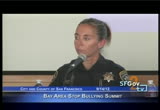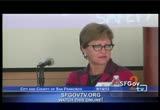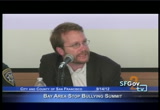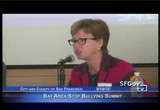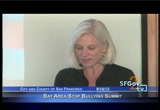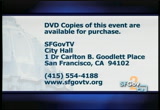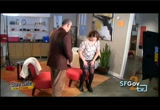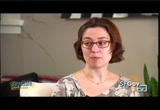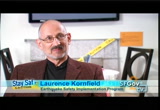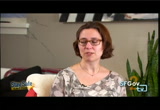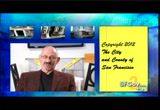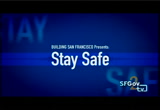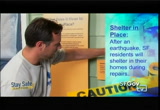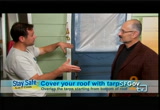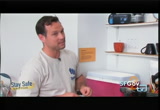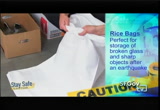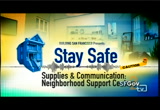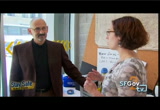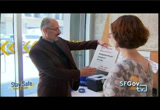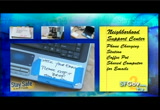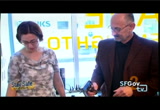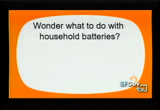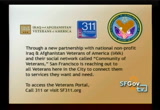tv [untitled] February 4, 2013 6:30pm-7:00pm PST
6:30 pm
across the last 15 years and noticed a trend what we called "net widening and net deepening" and more behaviors that fall under expulsion and suspending and when talking to administrators and their policies he found it helpful to speak of these terms in termses of behaviors and rather than saying we're criminalizing you and the think language is also important and i want to thank you for bringing up that point. it's something that i really advocate for and our caution to use zero tolerance and exclusionary discipline policies and also i teach teachers at san jose state and hundred students who are future teachers. >> can they do a projector? >> no. my teacher did, but again using social media,
6:31 pm
integrating all of the areas is so important for the prevention. thank you for that focus too and i think that gentleman has comments. >> i was going to follow up in the conversation with digital media or literacy needed within the educational system. we are still experiencing digital divide and access and just the one you speak of recently officer when you mention the generations and investigators not engaged with this media and no don't know my book or face space and when you have to look at youth culture. we talk about texting and sexing and omg and i didn't text anything to you. i spoke to and part of the language and how they engage so until we look at the culture of
6:32 pm
young people and how do we impact today's 20th century media culture we can't make a huge impact in regards to bullying or electronic aggression or whatever name we want to place on it and is affecting the students and i am excited you're addressing this issue and it's a crucial time for this generation and if we don't take serious this conversation today and action tomorrow we will see more and more issues arise. [applause] >> and i'm going to cap it up and i totally agree with that and one of the resources i want you to point is out is the family institute on line and platform for good a couple days ago. anne was there for the launch in dc and the goal of this whole thing is connect parents, educators and teens together to talk about both the
6:33 pm
eat your peas and how you stay a digital citizen and do the whole thing and i encourage everybody to check that out and i think that's the type of resource that will get us to where we need to go. it's called a "platform for good .org" and part of the family institute. >> yay. i think that's the way to cap it off really. let's lose the fear. let's bring -- it's safety, risk prevention, online risk prevention, whatever you want to call is is not the goal. it's important but not the goal. it's the mean to the end and the end is full safe effective successful engagement in participatory media and culture and society. this is a participatory medium that we're
6:34 pm
talking about in a network world. we're are in this environment and network participatory environment and our students need the tools. they need social emotional learning is a key tool and technical and literacy and media is behavioral so this has just been a fantastic day. thanks to all for coming and thank you everybody. i just want to share one piece of data which i don't understand completely. maybe our friend from facebook can explain, his twitter colleagues what they do. a hash tag was created and "stop bullying sf barb and hash tag and generated
6:35 pm
3 million personal impressions and 1.3 million followers within the last 24 hours. [applause] isn't that incredible? we talked about some of the dangers in social media today and i guess that's part of the beauty of social media and the video is part of that as well, so on behalf of all the childrens and families and parents and communities in the district i want to thank everybody for coming for all the work that you do. i feel optimistic in all of work that you do. thank you and go forth and do great work.
6:36 pm
6:37 pm
the deputy director of spur and one of the persons who pushed this shelter in place and safe enough to stay concept and we want to talk about what it means and why it's important to san francisco. >> as you know the bay area as 63% chance of having a major earthquake and it's serious and going to impact a lot of people and particularly people in san francisco because we live on a major fault so what does this mean for us? part of what it means is that potentially 25% of san francisco's building stock will be uninhibit tabl and people can't stay in their homes after an earthquake. they may have to go to shelters or leave entirely and we don't want that to happen.
6:38 pm
>> we want a building stock to encourage them to stay in the homes and encourage them to stay and not relocate to other locations and shelters. >> that's right so that means the housing needs to be safe enough to stay and we have been focused in trying to define what that means and you as a former building official knows better than anybody the code says if an earthquake happens it won't kill you but doesn't necessarily say that can you stay in your home and we set out to define what that might mean and you know because you built this house we're in now and this shows what it's like to be in a place safe enough to stay. it's not going to be perfect. there maybe cracks in the walls and not have gas or electricity within a while but can you essentially
6:39 pm
camp out within your unit. what's it going to take to get the housing stock up to this standard? we spent time talking about this and one of the building types we talk about was soft story buildings and the ground floor is vulnerable because there are openings for garages or windows and during the earthquake we saw in the marina they went right over and those are -- >> very vulnerable buildings. >> very and there are a lot of apartment buildings in san that that are like that. >> and time to. >> >> retrofit the buildings so people can stay in them after the earthquake. >> what do they need? do they need information? do they need
6:40 pm
incentives? mandates? >> that's a good question. i think it starts with information. people think that new buildings are earthquake proof and don't understand the performance the building will have so we want a transparent of letting people know is my building going to be safe in it after an earthquake? is my building so dangers i should be afraid of being injured? so developing a ranking system for buildings would be very important and i think for some of the larger apartment buildings that are soft story we need a mandatory program to fix the buildings, not over night and not without financial help or incentive, but a phased program over time that is reasonable so we can fix those buildings, and for the smaller soft story buildings and especially in san francisco and the houses over garages we need
6:41 pm
information and incentives and coaxing the people along and each of the owners want their house to be safe enough. >> we want the system and not just mandate everybody. >> that's right. >> i hear about people talking about this concept of resiliency. as you're fixing your knowledge you're adding to the city wide resiliency. >> >> what does that mean? >> that's a great question. what spur has done is look at that in terms of recovery and in new orleans with katrina and lost many of the people, hasn't recovered the building stock. it's not a good situation. i think we can agree and in san we want to rebuild well and quickly after a major disaster so we have defined what that means for our life lines. how do we need
6:42 pm
the gasolines to perform and water perform after an earthquake and the building stock as well, so we have the goal of 95% of our homes to be ready for shelter in place after a major earthquake, and that way people can stay within the city. we don't lose our work force. we don't lose the people that make san francisco so special. we keep everybody here and that allow us to recover our economy, and everything because it's so interdependent. >> so that is a difficult goal but i think we can achieve it over the long time so thank you very much for hosting us and hosting this great exhibit, and thank you very much for joining >> hey, san franciscans, here with the weekly buzz. it's the first week in february,
6:43 pm
and we have things that won't break the bank, they for all free. this tuesday, february 5 is free admission date for top museums. the dm and the leg end of honor. and after the trip to the museum, take a trip to the zoo, and offering free admission to residents. enjoy seeing all species in their surroundings, and other activities throughout the day. and if you are a baseball fan, i have a giant treat for you, this saturday at at&t park. the event will feature autographed sessions with the players and a chance to take
6:44 pm
pictures with the one and only championships. the event is free but get there early as the lines may be long. that's the weekly events. check us out on >> hi, i'm with building san francisco and we have a special program of stay safe today. but we're going to talk about what you can do to your home after an earthquake to make it waterproof and to be more comfortable. ♪ ♪ >> we're here at spur in san francisco, this wonderful exhibit of safe enough to stay. and this is an example of what your home might be like after an earthquake. and we have today with us ben latimer. thank you for joining us. >> my pleasure, good to see you. >> we're going to talk about things that you might do
6:45 pm
... >> hi, i'm with building san francisco. and we have a special program of stay safe today where we're going to talk about what you can do to your home after an earthquake to make it waterproof and to be more comfortable. we're here at spur in san francisco, this wonderful exhibit of safe enough to stay.
6:46 pm
and this is an example of what your home might be like after an earthquake. and we have today with us ben latimer from tvan. thank you for joining us. >> thank you. >> we'll talk about things you can do you don't have to be a professional contractor to make your home more livable after an earthquake. >> i want to talk about things a homeowner can do. we have comfort and we have things like a little bit of maybe safety if your front door is ajar and waterproofing if you have a leak in your roof, or if you have broken glass on the window. >> so unr, one of the most important fib use is keeping outside out and inside in. let's look at windows. >> let's assume this window is broken in the earthquake. we have wind and rain blowing in. one of the most important things you need to do as a homeowner is secure the plastic properly. if you just take staples or nails and put them into the plastic, we're going to get a strong wind and rip it right
6:47 pm
off. what i'm going to have somebody do is they're going to have -- this is an old piece of shingle. you might have -- everybody has a piece of wood in their basement. it doesn't have to be fancy. they take out this rusty screw begun, and hopefully you have one of these. >> there is one at the neighborhood support center. >> at the neighborhood support center. you're going to wrap this plastic around this board, take your screw. and then screw that in. >> you need a permit for this? >> you do need a permit for this. and you can contact the former head building inspector to get that permit. that's it. now when the wind blows, it's tight and it's not going to pull through, having a single point of contact. >> great. what about this door? take a look at this door. what can you do? let's say it doesn't shut tight. what can you do? >> for the sake of argument, we're on the inside. i can't lock my door at night. i have a very similar, very
6:48 pm
similar idea. i'm going to take my 2 by 4. i can put it across the jamb in the door. one. two. maybe i want another one up here, maybe another one down there. but i can go to sleep. and that quickly, i can get it off in the morning. >> terrific. what about the roof up here? we see people throw blue tarps over their roof after an earthquake. that seems reasonable. >> i think the blue tarp is reasonable. the things that people want to know that they need to know is if you have multiple tarps, how you overlap. starting from the bottom and moving up so that you're overlapping this way. so, rain running down doesn't slide under your tarp. >> right. >> and the same technique we did over here, as silly as it may sound, wrapping the end of that blue tarp with your board and then securing that if you can underneath, if you have to on top is fine. but making sure that you don't
6:49 pm
have an area where the wind is going to get under and bill owe that tarp. >> the wind can rip it right off. >> and then you're back up there again. >> let's go inside and check out what we can do inside. >> old fun. here we go. >> so, ben, i see you have nails, universal tool right here. >> man's best friend. duct tape. let me show you a couple things we can use this for after an earthquake. this window right here, because it's off kilter, we have open seams all along. i have a lot of air coming through. i want to stay comfortable at night. i want to keep that air out. it's as simple as that, all the way around. >> excellent. >> now i don't have any air coming in. let's say this one is one that would annoy me. everything is a little off. my doors won't stay closed. i take a piece of my favorite duct tape here, close it up. and at least it will stay out of my way when i'm trying to live throughout my day. if we're not talking about pressurized water, we're talking about just the drain,
6:50 pm
sometimes they're going to get a crack here. >> right, sure. >> and you're going to get a leak. duct tape around that is going to help us get through until we can get a plumber out and get that fixed as well. let's say we only have electricity in one room, so we're running extension cords across the house. if i'm going to run an extension cord from one room to the other, i don't want kids tripping on it. i don't want to trippon it. i take my trusty duct tape, tape it to the floor, and i don't have to worry about it getting kicked. >> great, great. look at this. let's look at the duct tape here because we see a big -- >> yes. in the event of an earthquake, i don't think we're going to have too many -- too much debris that's safe to put into a plastic bag, even as strong as it might be. these are called vice bags. this is what they use to put rice and things when they ship it. this is something where i take my glass, i can take broken pieces of wood, i can take anything sharp and fill it. and it's not going to puncture and come out. it's not going to fall all over the floor.
6:51 pm
i've not going to have it sticking out, maybe scratch myself, cut myself or anything like that. these are a great thing to have. >> you have a little go-to box for emergencies. that's great. thanks very much for joining us, ben. it's really been interesting. and i want to thank you all for joining us here at the spur urban center. and we'll see you again >> hi, in san francisco we're doing a special series called stay safe, about staying in your home after an earthquake. and today we're going to be talking about the neighborhood support center to help people find new resources when they stay in their home. ♪ ♪ >> we're here at the urban center in san francisco with sarah karlewski, deputy director of spur. we're talking about the
6:52 pm
shelter, a safe place to stay, exhibition at their center. and part of being able to shelter in place in your home is to be able to find a place nearby where you can get the services that you might not have in your home. and that's what this little neighborhood support center is for. >> that's right. >> what are some of the services that might be provided in a neighborhood center like this? >> yeah. so, we think of the neighborhood support centers as really being homes away from home. so, after a major earthquake there is going to be a lot of confusion. people are going to need to try to meet up with other people. they're going to need a lot of information. so, a lot of what the neighborhood support center is going to provide is that information. basically we're going to be like a hub where people can come to get services, help, information, et cetera. what you see here on this table are a whole variety of did you ever rent things from tools, some walki-talkies.
6:53 pm
this helps people know what is going on in their neighborhood. over here you have a whole variety of water and canned goods. we're really hoping that people will stock up for themselves at least for the first 72 hours if not more. i know that i have a ton of canned food and other sorts of things such as water within my own home. and everybody should, but there's going to come a time where people are going to end up running out and needing more. so, that's what we've got right here. >> so, this neighborhood support center, this doesn't look to be a major city sponsored fully stocked space. it can be a small commercial space, even somebody's garage as long as they have the information, a guide of information, who to call for what, communications equipment, some power, have a generator. >> that's right. >> thinking of lights and charge your cell phones and so on.
6:54 pm
and probably be operated by volunteers. >> volunteers, maybe members of nert could help out, people who live in the neighborhood that have some building skill could be helpful. so, if there is a structural engineer living nearby or even an architect, they could really help people kind of understand what has happened to their homes and what sort of repairs might be needed. >> here we are with some of the things that you might find in a neighborhood support center. one thing we learned from hurricane katrina, people really rely on their portable electronics and their phone. we say here's a charging station tied up to the generation. the essential coffeepot. >> yes. >> maybe a computer, you can check your e-mail with. >> yes. we have our charging station here. and then over here you can see we've got a whole variety of things, including the all-important different tags. so, lawrence, do you want to talk a little about the tags?
6:55 pm
>> sure. people want to know what do these tags mean. is my building safe or unsafe. these are the city owe initial tags. staying in your home doesn't require that you get a tag. it just means that you use common sense and maybe get help from people who might be around who can help you evaluate whether it's a safe place to stay. >> you might want to know because regular city services are disrupted, you might want to know when trash pick up is, if you need to get clean water, et cetera. also in the neighborhood support center, that kind of information would be available and we've got a little of that up here. >> trash pick up resumes regular schedule on wednesday. >> that's right. >> please mark your human waste. >> that's right. >> so, this is kind of an information center, communication center, also a center that hopefully will show people how to relate to their neighboring communities, what else is happening city-wide. and, of course, this is sort of the ubiquitous form of communication.
6:56 pm
my cat is missing, call me. >> exactly, because a lot of times, even if you do have a cell phone, and people do if you're really trying to save some of your precious energy minutes, et cetera, or it's not working as well as it normally does, it is helpful to have a message board that you can get information to other people. and, so, that's what we're showing here. you can see people are going to be looking for their pets. they're going to be looking for rides. people are going to need to be sharing resources a much as they possibly can. another thing that you can see here is they're going to need to be fair tools and some of the things that people are going to need in order to be able to stay safer within their homes. so, we're just showing sort of a gesture to that with all these different tools here. but then also tarps, people are going to need to cover their windows if their windows are cracked, if their roofs are broken. so, ideally, the city would be able to know where all these
6:57 pm
59 Views
IN COLLECTIONS
SFGTV2: San Francisco Government Television Television Archive
Television Archive  Television Archive News Search Service
Television Archive News Search Service 
Uploaded by TV Archive on

 Live Music Archive
Live Music Archive Librivox Free Audio
Librivox Free Audio Metropolitan Museum
Metropolitan Museum Cleveland Museum of Art
Cleveland Museum of Art Internet Arcade
Internet Arcade Console Living Room
Console Living Room Books to Borrow
Books to Borrow Open Library
Open Library TV News
TV News Understanding 9/11
Understanding 9/11
